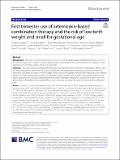| dc.contributor.author | Orvalho Augusto, Andy Stergachis, Stephanie Dellicour, Halidou Tinto, Anifa Valá, Maria Ruperez, Eusébio Macete, Seydou Nakanabo-Diallo, Adama Kazienga, Innocent Valéa, Umberto d’Alessandro, Feiko O Ter Kuile, Gregory S Calip, Peter Ouma, Meghna Desai, Esperança Sevene | |
| dc.date.accessioned | 2021-06-10T07:48:33Z | |
| dc.date.available | 2021-06-10T07:48:33Z | |
| dc.date.issued | 2020 | |
| dc.identifier.uri | https://repository.maseno.ac.ke/handle/123456789/3947 | |
| dc.description.abstract | Background: While there is increasing evidence on the safety of artemisinin-based combination therapy (ACT) for
the case management of malaria in early pregnancy, little is known about the association between exposure to ACT
during the frst trimester and the efect on fetal growth.
Methods: Data were analysed from prospective studies of pregnant women enrolled in Mozambique, Burkina Faso
and Kenya designed to determine the association between anti-malarial drug exposure in the frst trimester and
pregnancy outcomes, including low birth weight (LBW) and small for gestational age (SGA). Exposure to anti-malarial
drugs was ascertained retrospectively by record linkage using a combination of data collected from antenatal and
adult outpatient clinic registries, prescription records and self-reported medication usage by the women. Site-level
data synthesis (fxed efects and random efects) was conducted as well as individual-level analysis (fxed efects by
site).
Results: Overall, 1915 newborns were included with 92 and 26 exposed to ACT (artemether–lumefantrine) and
quinine, respectively. In Burkina Faso, Mozambique and Kenya at recruitment, the mean age (standard deviation) was
27.1 (6.6), 24.2 (6.2) and 25.7 (6.5) years, and the mean gestational age was 24.0 (6.2), 21.2 (5.7) and 17.9 (10.2) weeks,
respectively. The LBW prevalence among newborns born to women exposed to ACT and quinine (QNN) during
the frst trimester was 10/92 (10.9%) and 7/26 (26.9%), respectively, compared to 9.5% (171/1797) among women
unexposed to any anti-malarials during pregnancy. Compared to those unexposed to anti-malarials, ACT and QNN
exposed women had the pooled LBW prevalence ratio (PR) of 1.13 (95% confdence interval (CI) 0.62–2.05, p-value
0.700) and 2.03 (95% CI 1.09–3.78, p-value 0.027), respectively. Compared to those unexposed to anti-malarials
ACT and QNN-exposed women had the pooled SGA PR of 0.85 (95% CI 0.50–1.44, p-value 0.543) and 1.41 (95% CI
0.71–2.77, p-value 0.322), respectively. Whereas compared to ACT-exposed, the QNN-exposed had a PR of 2.14 (95%
CI 0.78–5.89, p-value 0.142) for LBW and 8.60 (95% CI 1.29–57.6, p-value 0.027) for SGA. The level of between sites
heterogeneity was moderate to high.
Conclusion: ACT exposure during the frst trimester was not associated with an increased occurrence of LBW or SGA.
However, the data suggest a higher prevalence of LBW and SGA for children born to QNN-exposed pregnancies. The
fndings support the use of ACT (artemether–lumefantrine) for the treatment of uncomplicated malaria during the
frst trimester of pregnancy | en_US |
| dc.subject | Low birth weight, Small for gestational age, Prospective cohort, Artemisinins, Sub-Saharan Africa, Pharmacovigilance | en_US |
| dc.title | First trimester use of artemisinin-based combination therapy and the risk of low birth weight and small for gestational age | en_US |
| dc.type | Article | en_US |

